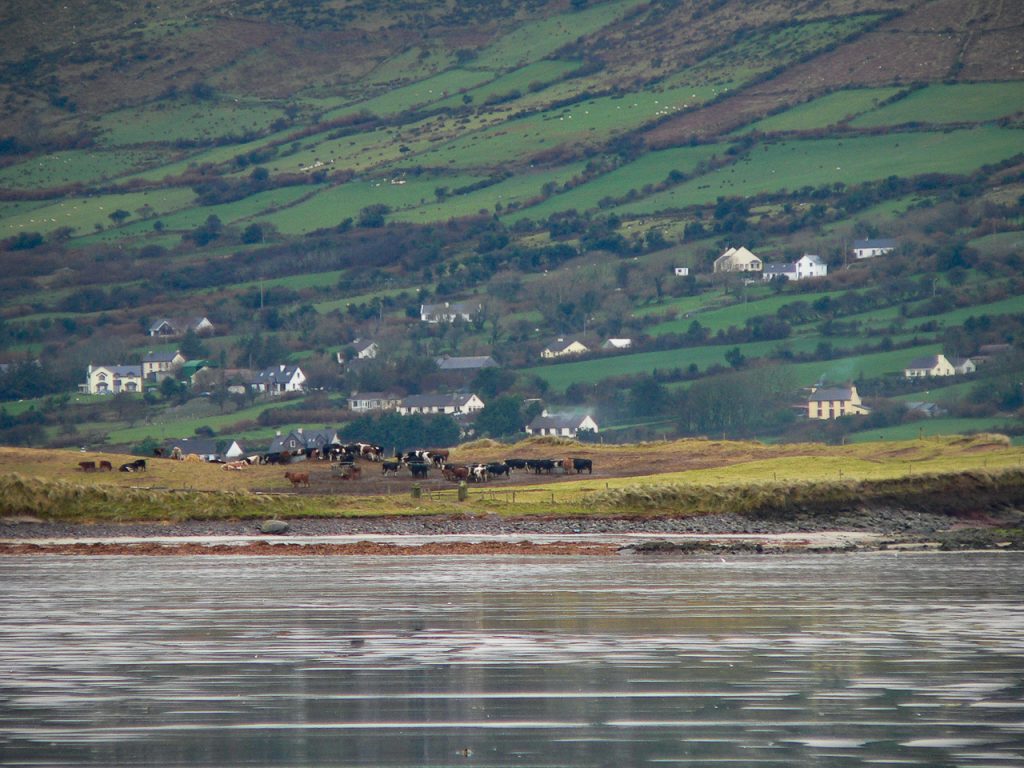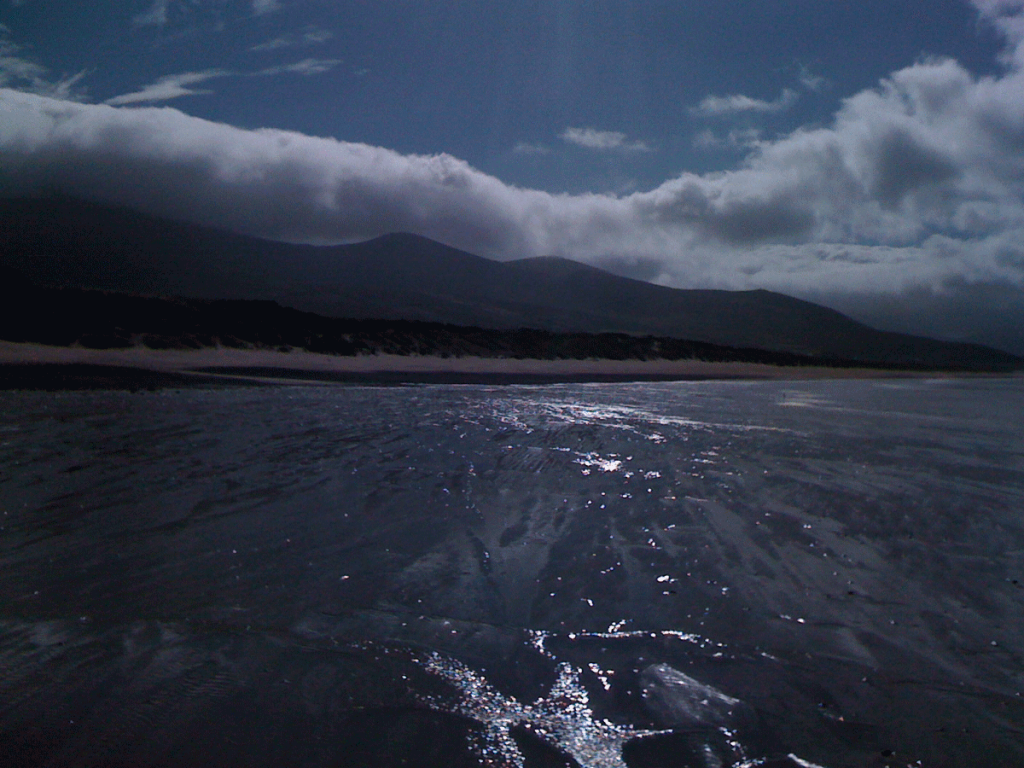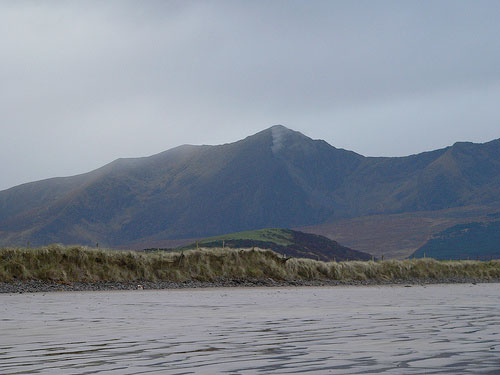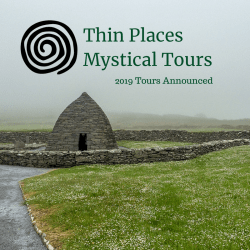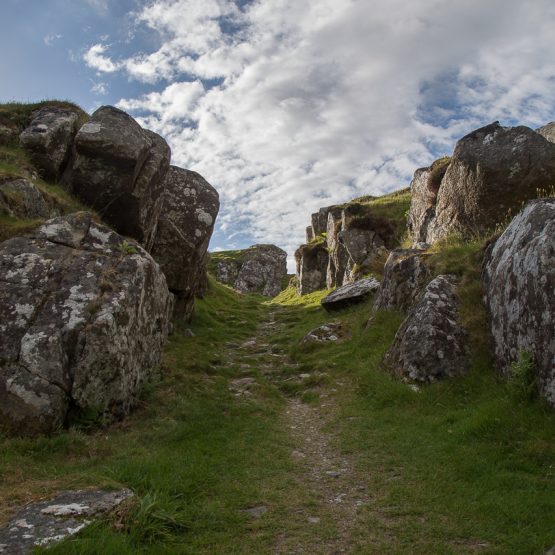The Man in the Sand in the Shadow of Mount Brandon
A Man in the Sand Appears on the Beach near Mount Brandon in Dingle
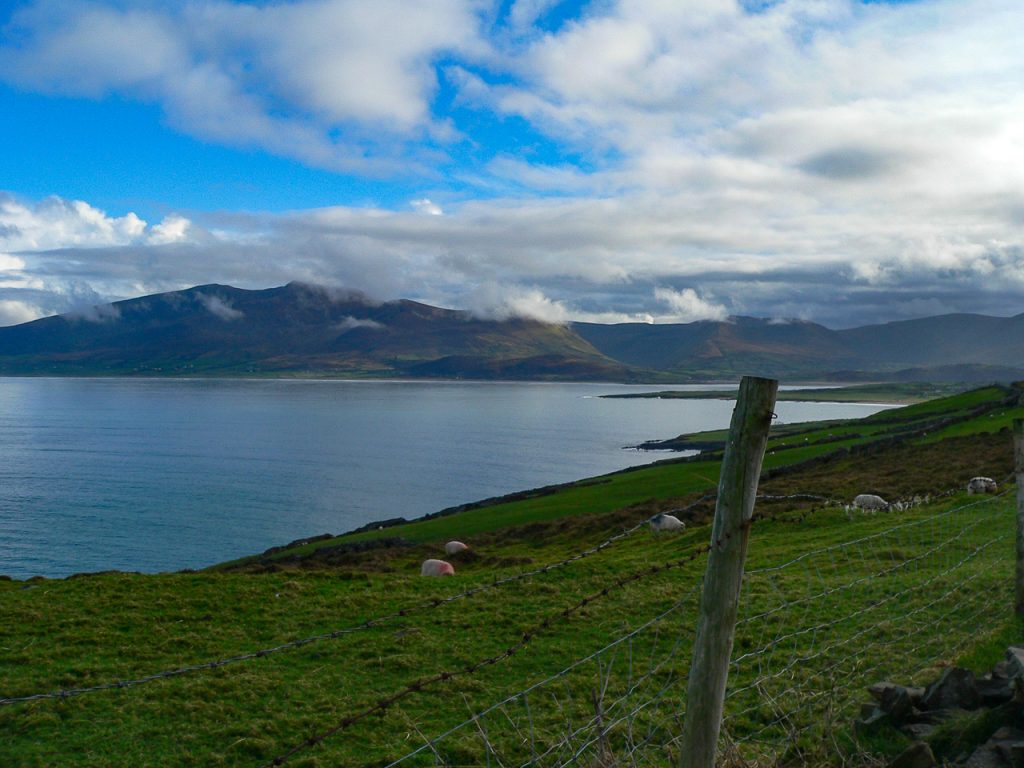
On a dreary February day many years ago, I was traveling alone in Ireland, doing some research for some writing I had to do on thin places in Ireland. Most of this day was spent on St. Brendan the Navigator who was born near Dingle and is a local heroic figure. I visited Ardfert, his first monastery, then Mount Brandon – the holy mountain named for him.
I was in a bad place personally when I wrote this travel journal entry. I’d been working on completing this book for years and I couldn’t move myself forward. No amount of research could push me to completion. Every time I started, I stopped. I had no confidence – filled with self doubt.
This was also a day of miracles – or coincidences. There’s something different about praying in a thin place, though. If you listen hard enough, sometimes you hear an answer or get a sign. This a day for one of those knock-you-in-the-head burning bush signs.
Travel Journal entry – February 20, 2009 – Ireland, Co. Kerry
Mount Brandon – coming from the north road into Dingle after passing the exits for Castlegregory, I came to Fermoyle strand. Mount Brandon dominates the landscape on all the north roads.
Mount Brandon is the second tallest mountain in Ireland and at its base, St. Brendan the Navigator is said to have launched his fleet of curraghs to set sail for the Promised Land as revealed to him in a vision. Prior to the voyage, he spent time on this holy mountain-top in reflection and prayer similar to St. Patrick’s retreat on Croagh Patrick. Also similar to Croagh Patrick, it’s likely that both holy mountains were considered sacred by the local people long before Christianity came to Ireland.
To say the scenery here is breathtaking would understate. It’s magical. The dismal sky and drizzle offered a blue-gray backdrop, but allowed just enough sunlight to illuminate the vivid green fields dotted by sheep at the base of the mountain. Down on the strand the wet sand at the shore is firm – almost like slate. The waves rush in and then Atlantic sucks the surf back out almost a half a mile – leaving various shapes in the flat sand. I was the only one on the strand. The only human image in that landscape.
I pulled into a little car park for people walking out to the beach. It started to rain buckets. So I sat in the car for awhile reading over notes and other authors’ writing about thin places in Ireland. I opened up an article by a well-known author – one whose work had appeared on the New York Times Best Seller list. Though I loved this author’s works of short fiction, I was disappointed in how sappy and trite this piece on thin places was. The writer overtold the meaning. The work left me feeling the writer was trying more to project a sense of spiritual superiority than remark on the mystery of a thin place.
I’m so judgy.
I thought to myself, “how is it that this successful author can get stuff like this published about this places, and I can’t write a word?”
Rain stopped. I continued my indulgence in self-pity as I walked out onto the strand. The tide was out and the sand seemed to stretch on forever. Mount Brandon dominated the landscape. I noticed a pale light hanging it illuminating a very low, wispy cloud just touching the peak. I was then then I stepped into the moment – feeling no passing of time… just being.
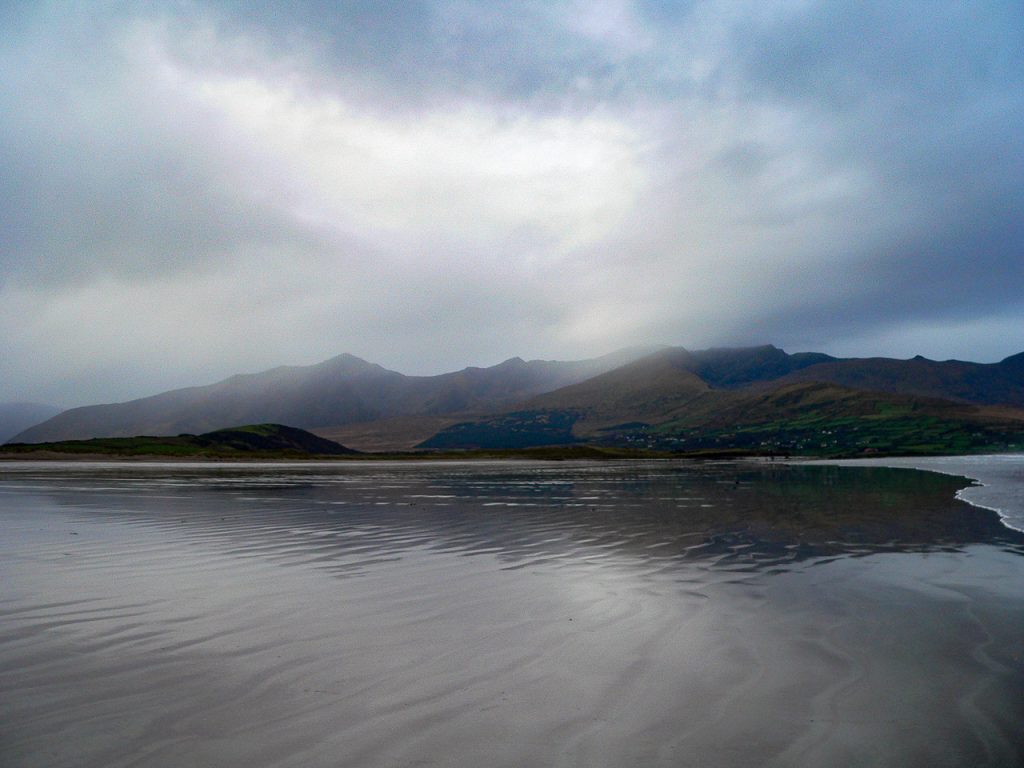
With a great sense of inadequacy, I turned to God, or whoever might be listening and said, “I can’t write. No matter how hard I try. I can’t write.”
My one-sided conversation was pretty anti-climactic. But then I looked down at the sand. There was an image created by the receding waves. It seemed to have a head, body, legs, and its right hand was extended with what looked like a flower or a box or something. It looked like a faceless man in a cloak. I thought, “Am I really seeing that? I’m just imagining that it looks like a man in the sand. But it didn’t wash away or fade away. So I started snapping pictures.
Even after fifteen minutes the man in the sand was just as clear as he was when I first noticed him. At times like this, I guess we try to find meaning. Was it a sign? Did it mean something? If so, what? I was reluctant to ascribe any meaning to the man, but it sure felt like …. something.
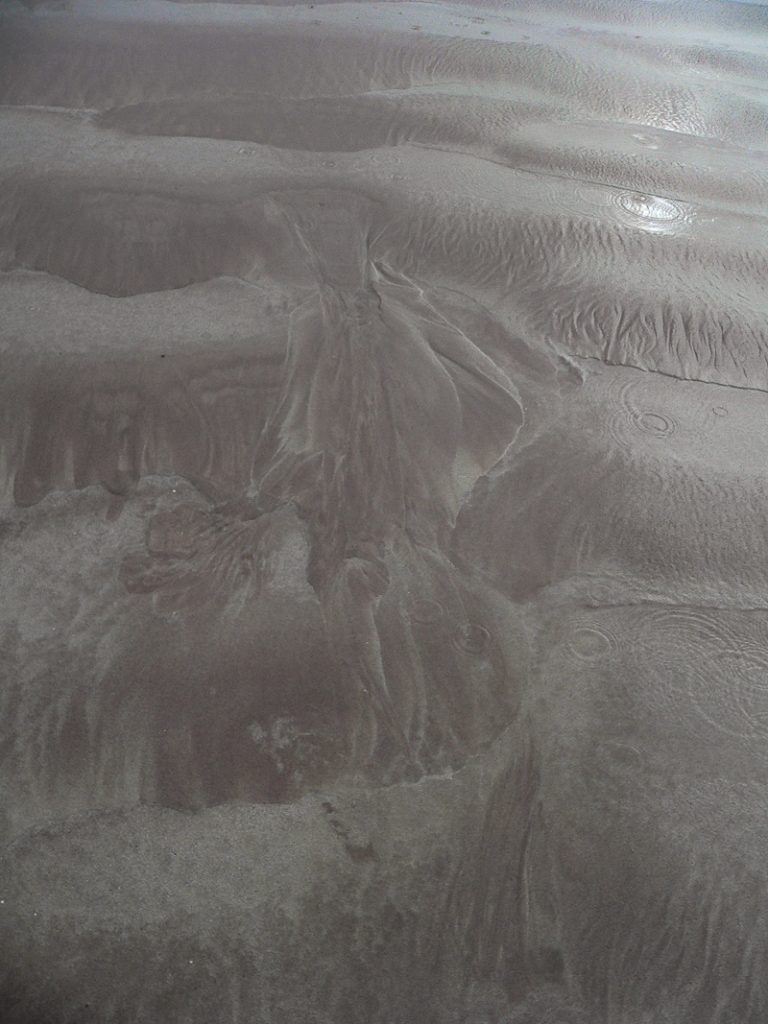
It was surely a synchronistic moment.
Caitlin and John Matthews remind us that we communicate with our five senses in the physical world, but we communicate with our spirit in the spirit world. They also give us insight on how to perceive coincidences moments of synchronicity – the simultaneous occurrence of events that appear significantly related but have no discernible causal connection. Here’s a quote referencing this from their book, Walkers Between the Worlds.
“… synchronicity… is actually an instance of an exact match between the fabric of our world and that of the Otherworld. While we normally dismiss such an occurrence as coincidental, in looking more deeply we can see the exact correspondences between one world and the other.”
After I was done with my man in the sand, I turned to leave. I was headed by car to the foot of Mount Brandon. There’s a road that winds around past Brandon village and ends at a place called Ballydavid north. It’s as far as you can go around Brandon Bay and the road ends at a little car park where one can take off up the mountain on foot. The rain was coming back and about to pour. The sky was black. As I turned to leave the beach I notice a bright ribbon of a rainbow in the eastern sky. Wow.
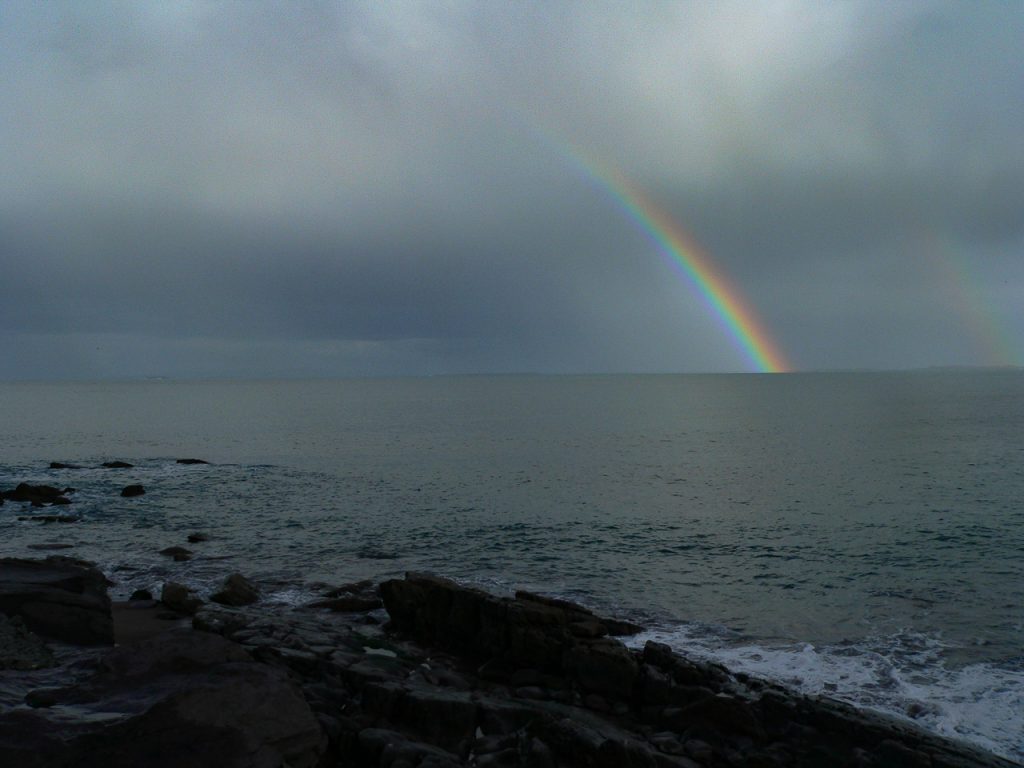
Another sign? Maybe. Maybe another coincidence.
I got to the car and headed out. For 20 minutes I drove and for 20 minutes that rainbow followed me. It was still there when I got to the foot of Mount Brandon. And I stayed there another twenty minutes as the rain fell and the sky cleared … watching it fade away. What a day.
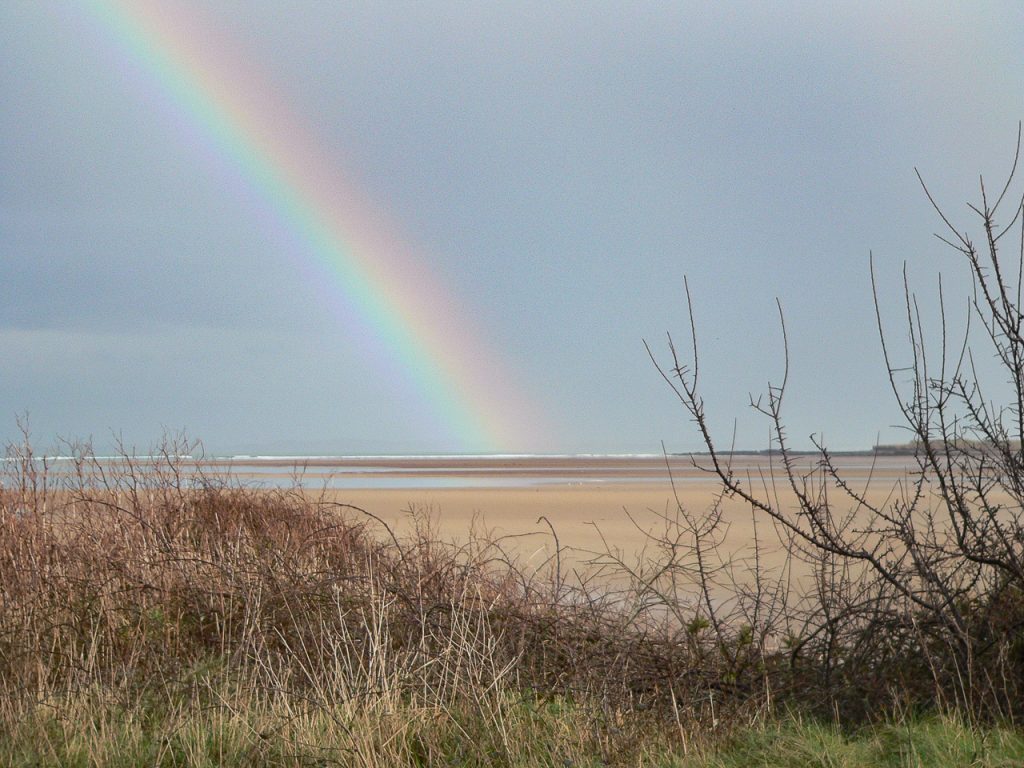
The eternal world or spirit world or Otherworld is one side of reality while our physical world is the other. But together they show us one world, one reality. A thin place brings us face to face with these two sides of one reality, and our prayers – our conversations with the Creator are whole and enjoy a sense of completeness.
Fermoyle Strand and Mount Brandon are thin places. At the time I was experiencing the above-mentioned synchronicity in Dingle I didn’t understand what any of it meant. Thus the importance of journaling and taking photo images. As we grow in spirit, so does our understanding.
And when I got home … I couldn’t stop writing. I’m still writing.
Mount Brandon – Named for St. Brendan
St. Brendan, one of the Twelve Apostles of Ireland, was a holy man and a navigator. He was born and raised in the Dingle area, and ordained a priest in 512 AD. Brendan was founder of several monastic settlements in Ireland, one being at the base of of a great mountain on Dingle’s north shore – now known as “Mount Brandon.”
The mountain was named after the famous St. Brendan, perhaps because he founded a monastic community here, or more likely because it was from the base of this mountain that St. Brendan launched his fleet of curraghs, filled with his followers, to set out on a seven year spiritually guided journey to find the “promised land” – the Isle of the Blest.
Legend states that St. Brendan climbed to the peak of Mount Brandon, looked across the Atlantic and saw the Americas. Many believe that Brendan reached North America way before Christopher Columbus, and several groups have alleged that Columbus referred to a manuscript that told of Brendan’s journey across the Atlantic. Much has been written about the Voyages of Brendan. What we know to be true is that Brendan grew spiritually on the journey and returned with the ability to draw large numbers into a deeper spiritual existence
St. Brendan is the patron saint of sailors and of travelers and is still reverenced in Ireland and around the Christian world. And the holy mountain, named for him, that dominates the northern landscape in Dingle is a reminder of where the journey began for a great spiritual leader, and where the journey begins – even today – for those that try to follow in his footsteps.
Brandon Head, the alleged launch site for Brendan and his followers, can only be accessed by foot. There is a pilgrim’s path that runs along the mountain that hikers and walkers traverse. The views from this trail are remarkable. But if you can’t take the walk, the views from Kilshannig, Castle Gregory or any of the strands off the northern road offer tremendous views. Often, the peak of Mount Brandon is hidden in the clouds.
Mount Brandon is a thin place. I had one of the strongest touches from the other world on a strand facing Mount Brandon. That story may come in another post.
Flickr photos for Mount Brandon.
St. Brendan’s Prayer
Shall I abandon, O King of mysteries, the soft comforts of home? Shall I turn my back on my native land, and turn my face towards the sea?
Shall I put myself wholly at your mercy, without silver, without a horse, without fame, without honour? Shall I throw myself wholly upon You, without sword or shield, without food and drink, without a bed to lie on? Shall I say farewell to my beautiful land, placing myself under Your yoke?
Shall I pour out my heart to You, confessing my manifold sins and begging forgiveness, tears streaming down my cheeks? Shall I leave the prints of my knees on the sandy beach, a record of my final prayer in my native land?
Shall I then suffer every kind of wound that the sea can inflict? Shall I take my tiny boat across the wide sparkling ocean? O King of the Glorious Heaven,
shall I go of my own choice upon the sea?
O Christ, will You help on the wild waves?
Kilshannig – The North Side of Dingle Littered with Bones
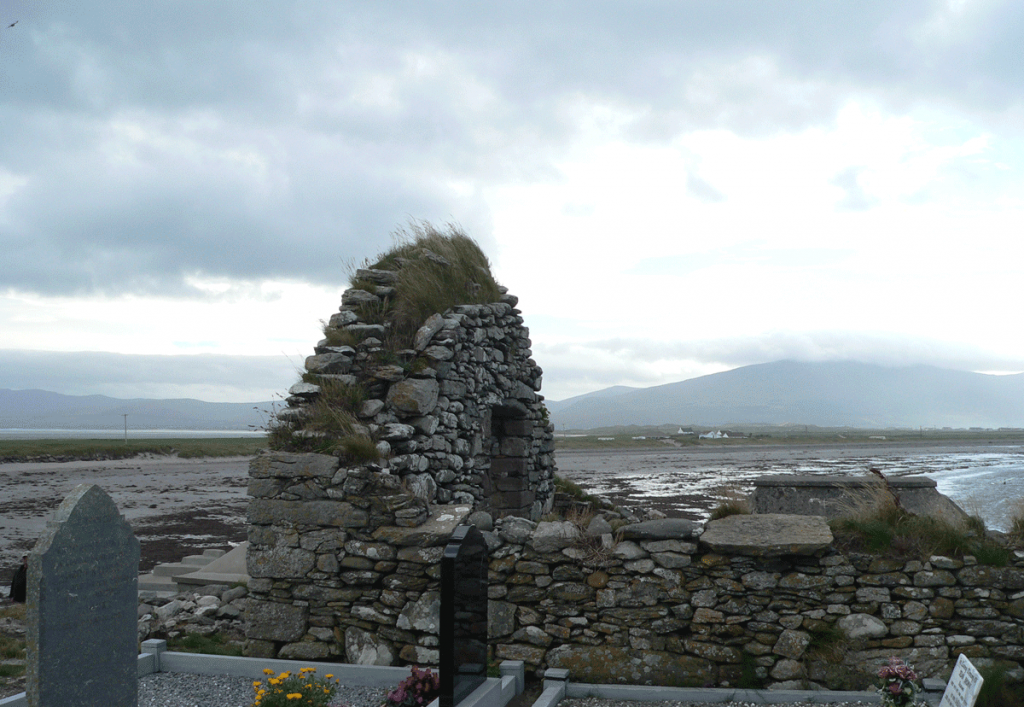
Church Ruin sitting on Brandon Bay in Kilshannig
One of the few places in Ireland I can photographically remember is Kilshannig, a small dilapidated village on the Dingle peninsula at its northernmost point. Most visitors that spend a day or less in Dingle seldom visit the northern route which has spectacular sea views, beautiful sandy beaches and commanding perspectives of Mount Brandon.
Just past Castlegregory is the turn-off to go out toward Rough Point. Kilshannig is a hilly village with a few small houses and narrow roads. We found cows wandering freely on the roadside and most of the buildings looked vacant. St. Senan or Seanaigh built a monastery in the Magharee Islands just off the coast of this village in the 7th century that was accessed by sea. A 15th century (some say earlier) church ruin now occupies the site at the edge of village overlooking Brandon Bay and the Atlantic Ocean. This little church was the mainland church for the monastery on the island.
7th Century Cross Slab – Kilshannig
Inside the church walls is cross-pillar slab from the 7th century. It has a Greek style cross carved on it and has been white washed. There are similar carvings on pillar slabs in Glencolmkille in County Donegal. It’s believed that the slabs were part of a pagan ritual before the area was Christianized. This may have served as a wayside marker. No one really knows for sure what these standing stones represented.
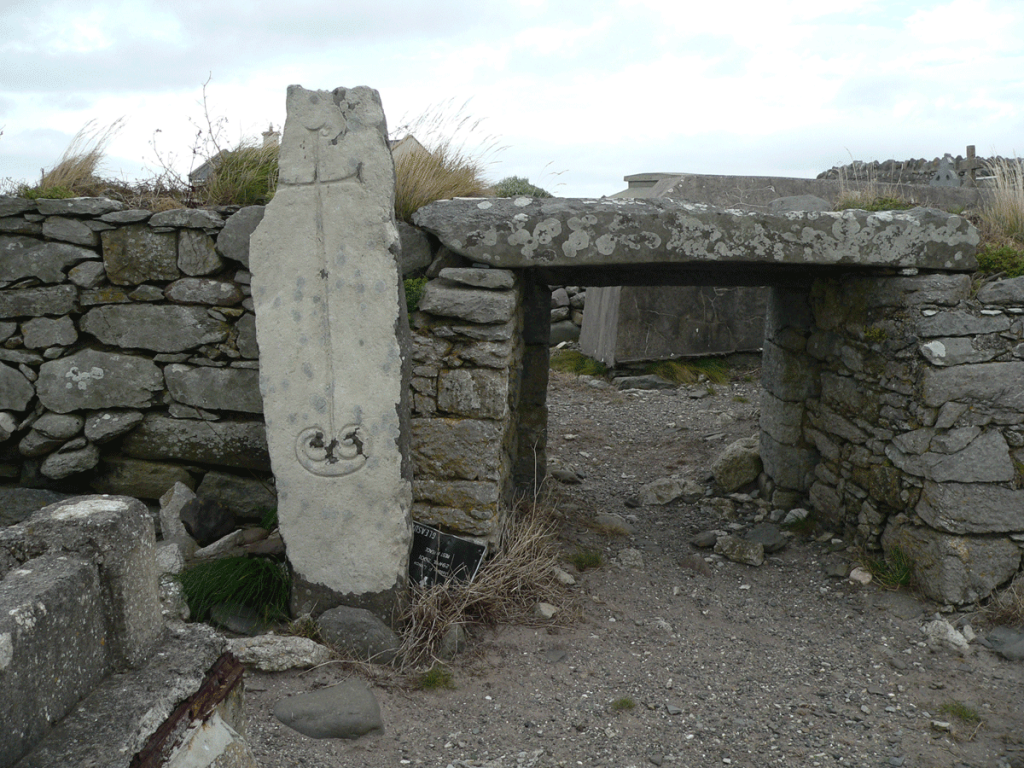
What a remarkable experience to add one’s own hands to the collection of thousands that have traced the engraved path of the cross on that ancient stone.
Cary Meehan, author of A Traveller’s Guide to Sacred Ireland writes:
“In the graveyard is a cross pillar with a fine incised cross with expanded terminals and a double spiral at its base, similar to those at Kilfountain, Kilmalkedar, and Reask.”
Graveyard is Being Reclaimed by the Sea – Bones Everywhere
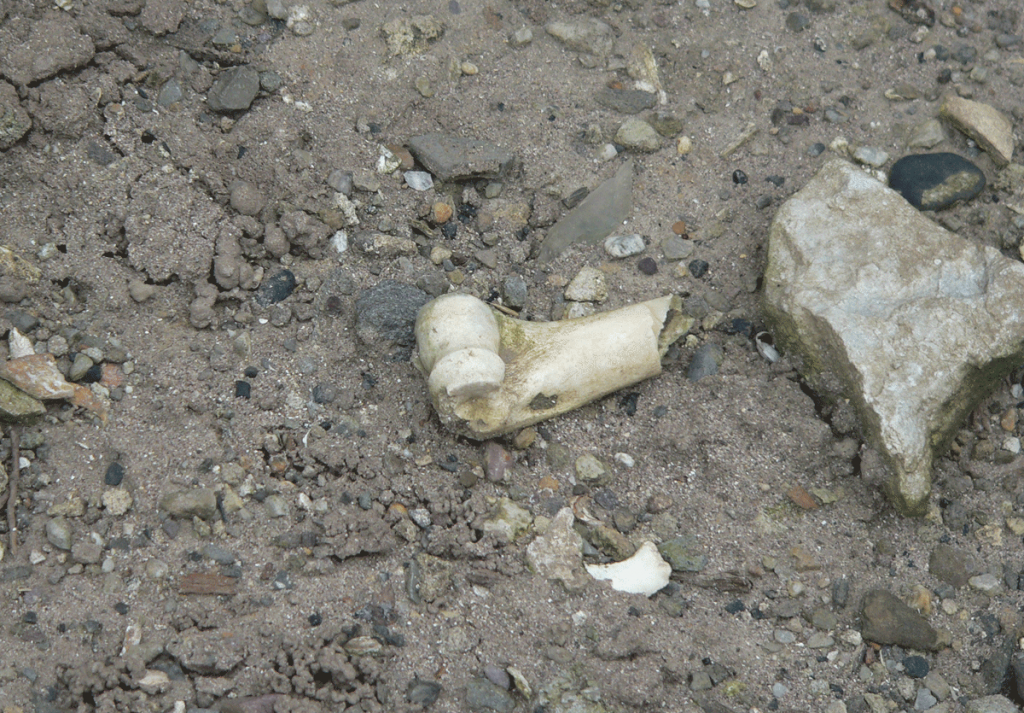
The ruined church was converted to a cemetery as were most of the church ruins in Ireland. And though the church was built on high ground above the sea, Brandon Bay has occasionally eclipsed the banks and invaded some of the old graves. Bones have washed out of the graves and litter the area in and around the church. While it was a somewhat macabre site for us, it was also a reminder that our remains join all the elements of nature eventually. We all return to dust.
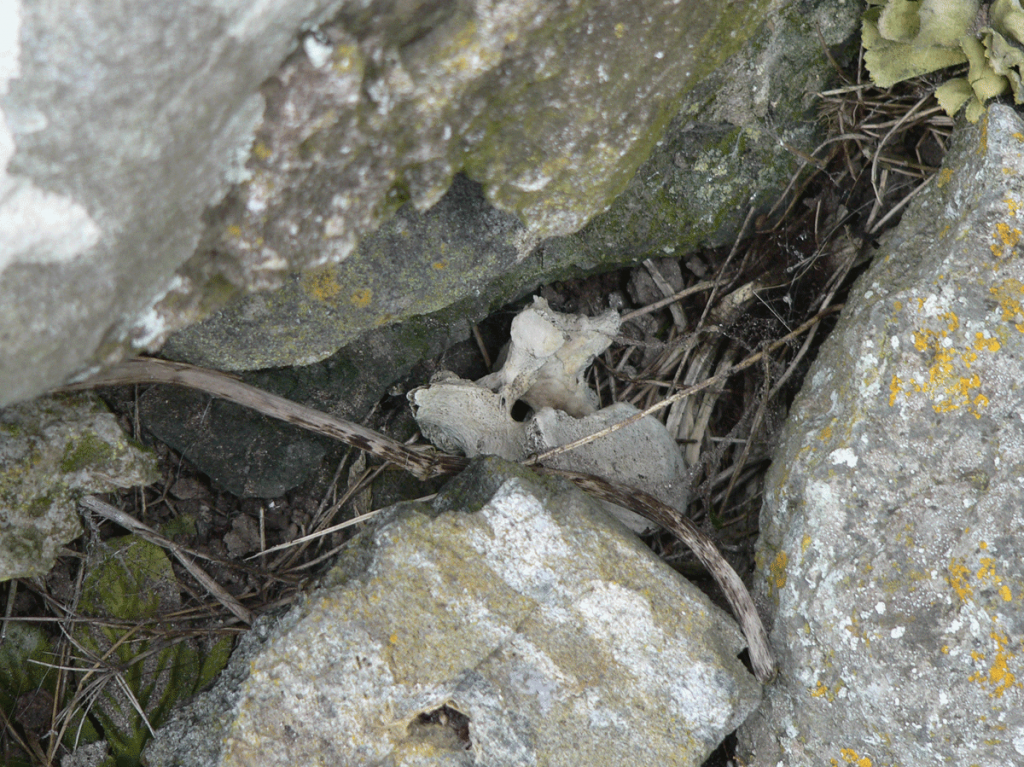
We found some interesting green chards scattered in one place. They had no sharp edges, either glass shards worn down by the sea or some type of stone.
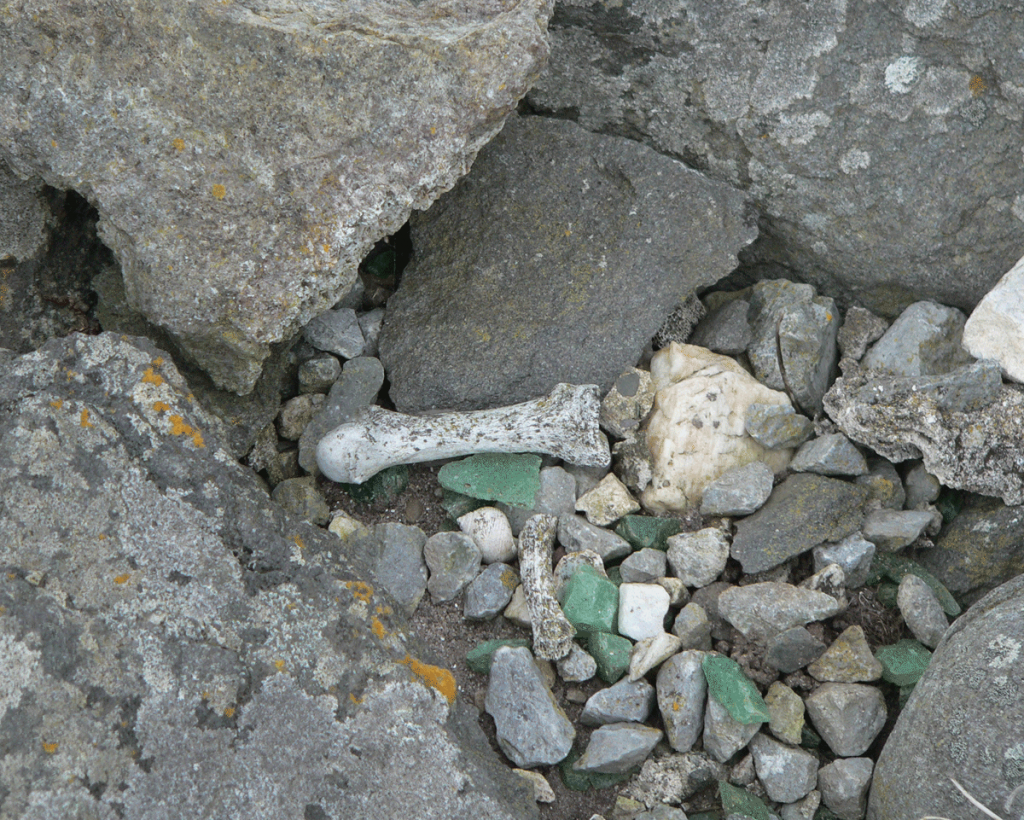
The views from Kilshannig are spectacular. Mount Brandon dominates the western view with Brandon Bay lapping up on a shoreline that extends nearly a half mile out to sea. In the distance, the crashing waves of the Atlantic Ocean can be seen and heard. The silence of the village – save for the wind and sea – is almost eerie. This is a holy place.
